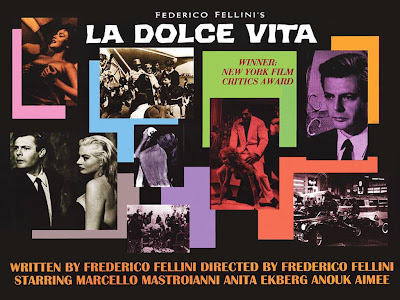In one of the most widely seen and acclaimed European movies of the 1960s,
Federico Fellini featured
Marcello Mastrioanni
as gossip columnist Marcello Rubini. Having left his dreary provincial
existence behind, Marcello wanders through an ultra-modern,
ultra-sophisticated, ultra-decadent Rome. He yearns to write seriously,
but his inconsequential newspaper pieces bring in more money, and he's
too lazy to argue with this setup. He attaches himself to a bored
socialite (
Anouk Aimée),
whose search for thrills brings them in contact with a bisexual
prostitute. The next day, Marcello juggles a personal tragedy (the
attempted suicide of his mistress (
Yvonne Furneaux)) with the demands of his profession (an interview with none-too-deep film star
Anita Ekberg).
Throughout his adventures, Marcello's dreams, fantasies, and nightmares
are mirrored by the hedonism around him. With a shrug, he concludes
that, while his lifestyle is shallow and ultimately pointless, there's
nothing he can do to change it and so he might as well enjoy it.
Fellini's hallucinatory, circus-like depictions of modern life first earned the adjective "
Felliniesque" in this celebrated movie, which also traded on the idea of Rome as a hotbed of sex and decadence. A huge worldwide success,
La Dolce Vita
won several awards, including a New York Film Critics CIrcle award for
Best Foreign Film and the Palme d'Or at the Cannes Film Festival.








